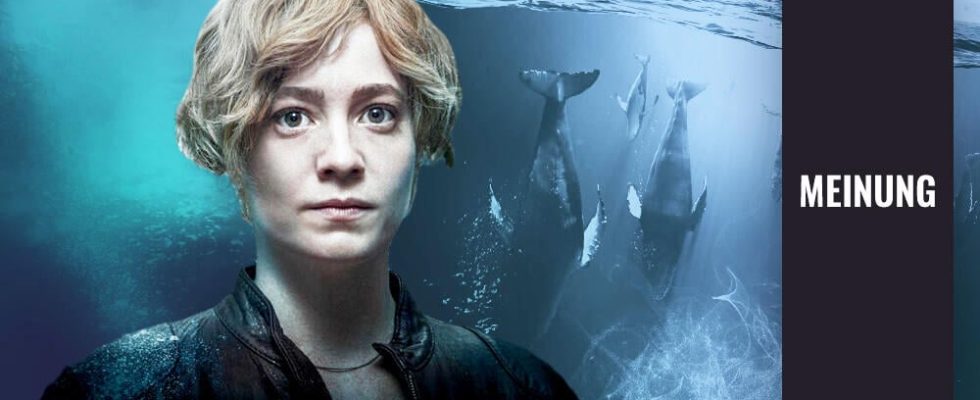Klaas never had a chance. At least when it comes to proving his acting skills in The Swarm. In the lavish ZDF series based on Frank Schätzing’s bestseller, the occasional actor is part of a respectable international ensemble, but his character seems as lifeless as an iceberg in the distant Arctic. The future of humanity and the blue planet is at stake in the story!
So how is it that a series with a great danger, a budget of 40 million euros and a red hot topic is told so – how do I put it best – comatose? The appearance of Klaas Heufer-Umlauf offers a key to the basic problem of the swarm.
Klaas plays the “born man catcher”
In both the series and the book, seafood and other creatures turn against people, tsunamis sweep over metropolises and all in all the situation looks rather suboptimal. Then deep-sea submersible boat leader Luther Roscovitz (Heufer-Umlauf) comes on the scene, who is supposed to help research the origin of this danger. In the official description of the ZDF he is as “charming and always up for a joke” described as “born man catcher”.
ZDF
A man catcher, as he is in the book
After viewing the eight episodes of the series, however, this description seems like pure mockery. Luther makes his first appearance in the second episode. In a scene lasting around two minutes, he stares intently at a collection of screens. Later in the episode, we see Luther again, this time staring at a cluster of screens in a roughly two-minute scene. If you read carefully, you will see a pattern.
Only in episode 7 is he allowed to show something like character in the ship’s mess when he complains to Charlie (Leonie Benesch) about her coffee brewing skills. For the now seasoned audience of The Swarm, that should be a red flag. If minor characters in the series show signs of an inner life, it is usually their death sentence.
The characters in The Swarm suffer from an illness
Luther suffers from swarm disease, even though he hasn’t even tasted the lobster. This affliction can be diagnosed with a simple but fatal symptom: excessive screen time. Luther stares at computer screens, Charlie stares at computer screens, Sigur (Alexander Karim) does the same and even Leon (Joshuar Odjick), who gets the most fresh air of all, is not immune to it.
The first six episodes of eight each have at least four longer scenes of screen staring, often there are more. In episode 4 I counted seven pieces. Sometimes the characters discuss scientific theories in these moments (who doesn’t like to remember the animations of ice worms?), often it’s video calls. Which is basically understandable for a series that was produced with an international cast during a pandemic. Somehow the character ensemble has to talk to each other.
More articles about The Swarm:
Because of the screen addiction, The Swarm seems like a tiring long-distance university seminar
ZDF
Welcome to the seminar
In The Swarm, however, this tendency mutates into a tiring screen addiction. In episode 5 there is a longer call in which Charlie shares her insights from the video of her deceased friend Jess (Andrea Guo). The problem: At this point we are seeing the video for the fourth time. First Jess records it, then Charlie watches it (for minutes), an episode later Charlie analyzes it again and then shows it to her professor (Barbara Sukowa). This video is obviously significant for the development of the plot. Not only is this type of narrative impressively inefficient, however. It also has a fatal consequence: it transforms The Swarm into a sequence of monotonous imagery. So many lighthouses can buckle One thing in particular remains in the memory of Der Schwarm: the atmosphere of the most expensive and boring long-distance university seminar of all time.
Even moments of tension culminate in the viewing of video material. The finale of the third episode, for example, is supposed to show the Yrr for the first time, the great threat of the series. However, it consists of a three-minute parallel montage in which two groups of scientists stare intensely at videos of murky underwater worlds. The episode finale is stretched out like a Japanese fountain girl is about to step off the screen. What we see, however, has at best the threat level of an unkempt guppy breeding station.
That’s why The Swarm seems so small and simply uncinematic, despite the 40 million budget. There is an incredible amount of speaking in the series, but little shown, experienced, involved or otherwise made tangible audiovisually.
An example of how things can be done differently is the lobster storyline in southern France. In it we follow the outbreak of a disease from the sea floor to the hospital, where Dr. Cecile Roche (Cécile de France) is experiencing her own little Contagion spin-off. The danger of the Yrr is made more oppressive here than in almost any other storyline in the series. By the way, in this second episode Roche does not have a video call. What you can’t say about Klaas and Co.
Podcast: Is the swarm a million dollar grave or better than its reputation?
The ZDF production Der Schwarm devoured around 40 million euros. The publication was accompanied by a lot of criticism. Even bestselling author Frank Schätzing took a stand against the series.
At this point you will find external content that complements the article. You can show it and hide it again with one click.
In the podcast we therefore talk about the qualities of the series. Are millions of euros wasted here or can The Swarm keep up with the big competition from Hollywood? In addition, we speculate in the spoiler section whether the finale prepares for a second season.
